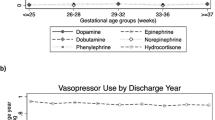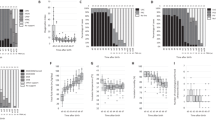Abstract
Background:
Clinicians frequently use hydrocortisone (HC) to treat vasopressor-resistant hypotension even before establishing its cause.
Objective:
To identify the etiologic factors leading to development of refractory hypotension, and to assess if patent ductus arteriosus (PDA) is associated with refractory hypotension during the first week of life.
Study design:
The medical records of 290 consecutively born infants ⩽30 weeks' gestational age (GA) were reviewed to identify the escalating need for vasopressors to maintain mean arterial blood pressure (MABP) at or above a level equal to the GA in completed weeks. Refractory hypotension was defined as MABP unresponsive to fluid boluses and high-dose vasopressors (dopamine and dobutamine at doses 20 μg/kg/min each and/or epinephrine) prompting the use of HC.
Results:
Eighty-nine (30.7%) of 290 infants had refractory hypotension between postnatal days 2 and 7. Infants with refractory hypotension were more likely to have a lower birth weight and GA (P<0.001), been treated with surfactant (P=0.004) and received indomethacin for a symptomatic PDA (P<0.001). To identify the etiologic factors, a univariate analysis revealed that the use of high-frequency oscillatory ventilation, presence of air leaks, PDA, sepsis, hyperkalemia and intraventricular hemorrhage (IVH) were significantly associated with refractory hypotension. However, multivariate analysis confirmed the independent association of only PDA (odds ratio (OR) 7.6, 95% confidence interval (CI) 3.3–17.7, P=0.000), severe IVH (OR 2.6, 95% CI 1.1–6.4, P=0.03) and GA (OR 0.7, 95% CI 0.6–0.8, P=0.001).
Conclusions:
Evaluation for early ductal shunting and closure of the ductus, if patent, should be attempted before HC is considered in hypotensive infants with escalating needs for vasopressors.
This is a preview of subscription content, access via your institution
Access options
Subscribe to this journal
Receive 12 print issues and online access
$259.00 per year
only $21.58 per issue
Buy this article
- Purchase on Springer Link
- Instant access to full article PDF
Prices may be subject to local taxes which are calculated during checkout
Similar content being viewed by others
References
Goldstein RF, Thompson Jr RJ, Oehler JM, Brazy JE . Influence of acidosis, hypoxemia and hypotension on neurodevelopmental outcome in very low birth weight infants. Pediatrics 1995; 95: 238–243.
Mattia FR, deRegnier RA . Chronic physiologic instability is associated with neurodevelopmental morbidity at one and two years in extremely premature infants. Pediatrics 1998; 102 (3): E35.
Fanaroff JM, Wilson-Costello DE, Newman NS, Montpetite MM, Fanaroff AA . Treated hypotension is associated with neonatal morbidity and hearing loss in extremely low birth weight infants. Pediatrics 2006; 117 (4): 1131–1135.
Al-Aweel I, Pursley DM, Rubin LP, Shah B, Weisberger S, Richardson DK . Variations in prevalence of hypotension, hypertension, and vasopressor use in NICUs. J Perinatol 2001; 21 (5): 272–278.
Seri I . Hydrocortisone and vasopressor-resistant shock in preterm neonates. Pediatrics 2006; 117 (2): 516–518.
Dempsey EM, Barrington KJ . Diagnostic criteria and therapeutic interventions for the hypotensive very low birth weight infant. J Perinatol 2006; 26 (11): 677–681.
Evans N, Moorcraft J . Effect of patency of the ductus arteriosus on blood pressure in very preterm infants. Arch Dis Child 1992; 67: 1169–1173.
Evans N, Iyer P . Change in blood pressure after treatment of patent ductus arteriosus with indomethacin. Arch Dis Child 1993; 68: 584–587.
Clyman RI . Recommendations for the postnatal use of indomethacin: an analysis of four separate treatment strategies. J Pediatr 1996; 128 (5 Pt 1): 601–607.
Gersony WM, Peckham GJ, Ellison RC, Miettinen OS, Nadas AS . Effects of indomethacin in premature infants with patent ductus arteriosus: results of a national collaborative study. J Pediatr 1983; 102 (6): 895–906.
Eronen M, Kari A, Pesonen E, Hallman M . The effect of antenatal dexamethasone administration on the fetal and neonatal ductus arteriosus. A randomized double-blind study. Am J Dis Child 1993; 147 (2): 187–192.
Report of a Joint Working Group of the British Association of Perinatal Medicine and the Research Unit of the Royal College of Physicians. Development of audit measures and guidelines for good practice in the management of neonatal respiratory distress syndrome. Arch Dis Child 1992; 67: 1221–1227.
Seri I . Management of hypotension and low systemic blood flow in the very low birth weight neonate during the first postnatal week. Journal of Perinatology 2006; 26: S8–S13.
Skinner J . Diagnosis of PDA. Semin Neonatol 2001; 6: 49–61.
Seri I, Noori S . Diagnosis and treatment of neonatal hypotension outside the transitional period. Early Human Dev 2005; 81 (5): 405–411.
Zubrow AB, Hulman S, Kushner H, Falkner B . Determinants of blood pressure in infants admitted to neonatal intensive care units: a prospective multicenter study. J Perinatol 1995; 15: 470–479.
Revich M, Brann A, Shapiro HM, Myers RE . Regional cerebral blood flow during prolonged partial asphyxia In: Meyer JS, Reivich M, Lechner H et al. (eds) Research on the Cerebral Circulation 1972. Thomas: Springfield, IL.
Watterberg KL, Gerdes JS, Cole CH, Aucott SW, Thilo EH, Mammel MC et al. Prophylaxis of early adrenal insufficiency to prevent bronchopulmonary dysplasia: a multicenter trial. Pediatrics 2004; 114: 1649–1657.
Author information
Authors and Affiliations
Corresponding author
Rights and permissions
About this article
Cite this article
Sarkar, S., Dechert, R., Schumacher, R. et al. Is refractory hypotension in preterm infants a manifestation of early ductal shunting?. J Perinatol 27, 353–358 (2007). https://doi.org/10.1038/sj.jp.7211749
Received:
Revised:
Accepted:
Published:
Issue Date:
DOI: https://doi.org/10.1038/sj.jp.7211749
Keywords
This article is cited by
-
Surgical Ligation Versus Percutaneous Closure of Patent Ductus Arteriosus in Very Low-Weight Preterm Infants: Which are the Real Benefits of the Percutaneous Approach?
Pediatric Cardiology (2018)
-
Microcirculatory mechanisms in postnatal hypotension affecting premature infants
Pediatric Research (2013)



